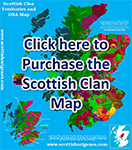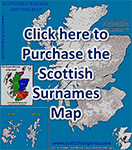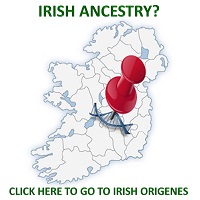You are here
Roman DNA in Scotland, the mystery of the Ninth Legion solved?
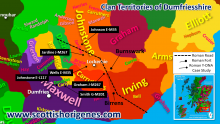 A surprise finding from 10 years of Scottish Origenes Y-DNA Case Studies was the considerable number of males with Mediterranean-associated Y-DNA Haplogroups. Intriguingly, each Scottish Origenes Y-DNA Case Study with a Mediterranean-associated Haplogroup also had a pinpointed origin within Scotland that was located close to a Roman ruin or road. Even more surprising was that the majority closter together within a small area of Dumfriesshire close to the English border and surrounding a prominent Roman Road and located close to two significant Roman fortifications (Burnswalk and Birrens). Many Scottish surnames denote the ethnicity of their ancestors; Welsh/Wallace (Ancient Celt/Briton), Scott (Scots Gaels), Ireland (Irish), Inglis (English), Haldane (Half Dane), and Rome (Roman), the latter of which is also exclusive to Dumfriesshire! Today, the Dumfriesshire Scots who appear to be descended from Roman settlers in Scotland have surnames like Rome, Wells, Smith, Kirkpatrick, Graham, Jardine, and Johnstone; all of whom have left evidence of their long historical links with the Southern Borderlands of Scotland in its placenames and castles/towerhouses. Surnames appeared in Scotland an estimated 1,000 years ago, so the fact that at least one individual would acquire the surname ‘Rome,’ indicates that the locals of Southern Scotland in 1000AD were aware of its Roman history.
A surprise finding from 10 years of Scottish Origenes Y-DNA Case Studies was the considerable number of males with Mediterranean-associated Y-DNA Haplogroups. Intriguingly, each Scottish Origenes Y-DNA Case Study with a Mediterranean-associated Haplogroup also had a pinpointed origin within Scotland that was located close to a Roman ruin or road. Even more surprising was that the majority closter together within a small area of Dumfriesshire close to the English border and surrounding a prominent Roman Road and located close to two significant Roman fortifications (Burnswalk and Birrens). Many Scottish surnames denote the ethnicity of their ancestors; Welsh/Wallace (Ancient Celt/Briton), Scott (Scots Gaels), Ireland (Irish), Inglis (English), Haldane (Half Dane), and Rome (Roman), the latter of which is also exclusive to Dumfriesshire! Today, the Dumfriesshire Scots who appear to be descended from Roman settlers in Scotland have surnames like Rome, Wells, Smith, Kirkpatrick, Graham, Jardine, and Johnstone; all of whom have left evidence of their long historical links with the Southern Borderlands of Scotland in its placenames and castles/towerhouses. Surnames appeared in Scotland an estimated 1,000 years ago, so the fact that at least one individual would acquire the surname ‘Rome,’ indicates that the locals of Southern Scotland in 1000AD were aware of its Roman history.
How does Roman DNA end up in Scotland? Either the Romans left lots of DNA among the local girls, or the Romans had willingly settled in significant numbers in Dumfriesshire. The fact that today Roman Y-DNA may account for an estimated 50% of males that farm the lands between Dumfries and Lockerbie would suggest it was a permanent settlement. But the Romans did not (as far as history is concerned) settle permanently in Scotland (retreating behind Hadrians Wall). Which raises the possibility that the Scots Border Kirkpatricks, Grahams, Jardines, and Johnstones could be the descendants of the lost Roman Ninth Legion which reportedly dissappeared in Scotland?
The Ninth Legion was formed in Spain by Pompeii the Great and later served in Gaul under Julius Caesar. The Ninth’s history is intricately linked with the destruction of the Celtic Gauls, a process which the DNA studies have revealed led to substantial number of Gaulish refugees taking ultimate refuge in Scotland and Ireland (as the Romans advanced through Britain, see from Gauls to Gael click here). The Ninth Legion is last mentioned in Northern Scotland where their night camp suffered a surprise raid by the Caledonians. Could it be that the Ninth Legion was annihilated by the refugee Gauls who together with their Caledonian hosts exacted a terrible revenge? Then, in an ancient Roman cover-up, the survivors of the Ninth were quietly settled in Dumfriesshire. Unlikely, as archaeology reveals that the Ninth was engaged in the rebuilding of the legionary fortress at York (Eboracum) in 108AD. This is recorded in an inscribed stone tablet discovered in 1864.
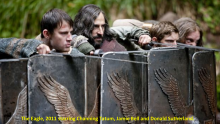 There is another theory (by historian Theodor Mommsen) that the legion was wiped out in action in Scotland soon after 108AD, perhaps during a rising of northern tribes against Roman rule. This view was popularised by the 1954 novel The Eagle of the Ninth in which the legion is said to have marched into Caledonia (modern day Scotland), after which it was "never heard of again". That book spawned an impressive Hollywood film (The Eagle) which I thoroughly enjoyed and highly recommend. One surprising moment of the film is when the main character finds a group of Roman Legionnaires from the Ninth Legion who had survived the ‘massacre’ and rather than return in shame had settled in Scotland (in Dumfriesshire perhaps???). It all makes for a great Hollywood film, but the truth is probably far more prosaic. It is more likely that Dumfriesshire was a focal point for trade between Roman and the natives of Scotland, with a considerable number of Romans settling permanently, and in time changing the genetic landscape of the area. Either way, the descendants of those Romans would thrive, and in time give rise to prominent Border Scots clans like the Grahams, Jardines, and Johnstons. Many of these Roman-Scots from Dumfriesshire would migrate to Ireland in the early 1600’s becoming ‘Scots Irish’ and then later venture to the Americas. Their descendants would give rise to one US President, Lyndon B. Johnson, (whom the Johnstones of Dumfriesshire claim as their own).
There is another theory (by historian Theodor Mommsen) that the legion was wiped out in action in Scotland soon after 108AD, perhaps during a rising of northern tribes against Roman rule. This view was popularised by the 1954 novel The Eagle of the Ninth in which the legion is said to have marched into Caledonia (modern day Scotland), after which it was "never heard of again". That book spawned an impressive Hollywood film (The Eagle) which I thoroughly enjoyed and highly recommend. One surprising moment of the film is when the main character finds a group of Roman Legionnaires from the Ninth Legion who had survived the ‘massacre’ and rather than return in shame had settled in Scotland (in Dumfriesshire perhaps???). It all makes for a great Hollywood film, but the truth is probably far more prosaic. It is more likely that Dumfriesshire was a focal point for trade between Roman and the natives of Scotland, with a considerable number of Romans settling permanently, and in time changing the genetic landscape of the area. Either way, the descendants of those Romans would thrive, and in time give rise to prominent Border Scots clans like the Grahams, Jardines, and Johnstons. Many of these Roman-Scots from Dumfriesshire would migrate to Ireland in the early 1600’s becoming ‘Scots Irish’ and then later venture to the Americas. Their descendants would give rise to one US President, Lyndon B. Johnson, (whom the Johnstones of Dumfriesshire claim as their own).
What will your DNA reveal? Contact Scottish Origenes (CLICK HERE) for a FREE consultation on your DNA results.


